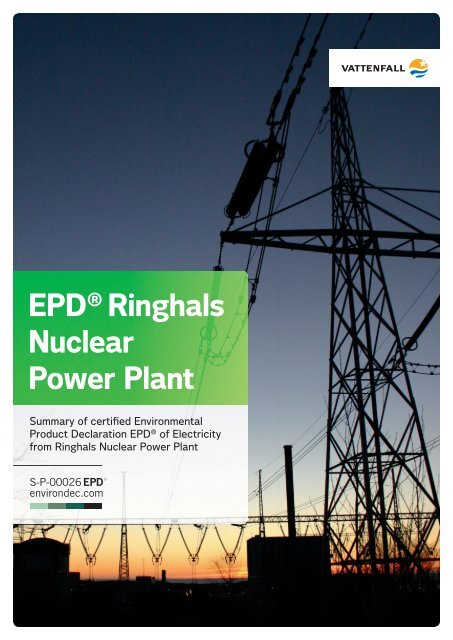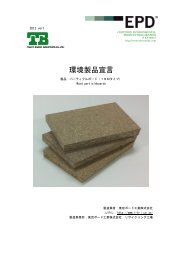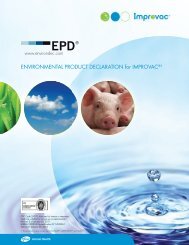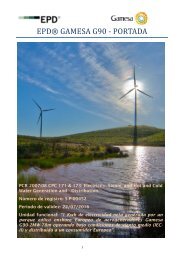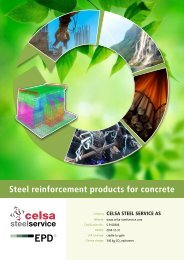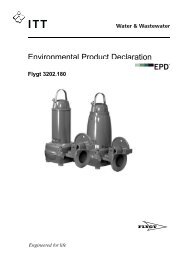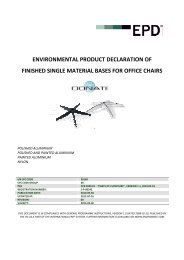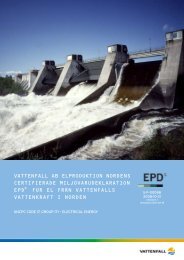Summary of the EPD
Summary of the EPD
Summary of the EPD
Create successful ePaper yourself
Turn your PDF publications into a flip-book with our unique Google optimized e-Paper software.
<strong>EPD</strong> ® Ringhals<br />
Nuclear<br />
Power Plant<br />
<strong>Summary</strong> <strong>of</strong> certified Environmental<br />
Product Declaration <strong>EPD</strong> ® <strong>of</strong> Electricity<br />
from Ringhals Nuclear Power Plant<br />
S-P-00026
S-P-00026<br />
2010-02-16<br />
Vattenfall AB<br />
<strong>Summary</strong> <strong>of</strong> certified Environmental Product Declaration <strong>EPD</strong> ®<br />
<strong>of</strong> Electricity from Ringhals Nuclear Power Plant<br />
UNCPC Code 17, Group 171 – Electrical energy<br />
2 ©2011 Vattenfall AB, <strong>EPD</strong> Ringhals
Producer<br />
Ringhals AB (RAB) is responsible for <strong>the</strong> electricity<br />
generation in <strong>the</strong> Ringhals nuclear power plants north<br />
<strong>of</strong> Varberg at <strong>the</strong> Swedish East coast. Ringhals AB is<br />
owned to 70,4% by Vattenfall AB, SE–162 87 Stockholm,<br />
telephone +46 8 739 50 00. Ringhals AB has<br />
an environmental management system certified and<br />
registered according to ISO 14001/EMAS and OHAS<br />
18001/AFS 2001:1.<br />
Product and declared unit<br />
Electricity belongs to <strong>the</strong> product category UNCPC<br />
Code 17, Group 171 – Electrical energy. The nuclear<br />
power plant (NPP) comprised <strong>of</strong> one Boiling Water<br />
Reactor (BWR) and three pressurized-water reactors<br />
(PWR) <strong>of</strong> toge<strong>the</strong>r app. 3707 MW generates an average<br />
year 24,7 TWh. The reactors are <strong>of</strong> type generation<br />
II and a once-through fuel cycle is applied i.e.<br />
no reprocessing <strong>of</strong> fuel. Ringhals NPP is a base load<br />
plant. The declared unit is 1 kWh electricity net generated<br />
and <strong>the</strong>reafter distributed to a customer connected<br />
to <strong>the</strong> Swedish regional grid (70/130 kV).<br />
Environmental performance –<br />
based on LCA<br />
See section 3 <strong>of</strong> <strong>the</strong> complete <strong>EPD</strong> ® documentation.<br />
System boundaries<br />
The <strong>EPD</strong> ® comprises <strong>the</strong> generation <strong>of</strong> electricity<br />
in <strong>the</strong> nuclear power plant, Upstream processes i.e.<br />
uranium fuel production and production <strong>of</strong> auxiliary<br />
supplies and Downstream processes i.e. distribution <strong>of</strong><br />
electricity. Fur<strong>the</strong>r construction and dismantling <strong>of</strong> <strong>the</strong><br />
nuclear power plant and <strong>the</strong> facilities for radioactive<br />
waste handling has been included, Core-Infrastructure.<br />
The use stage <strong>of</strong> electricity at <strong>the</strong> consumer is<br />
not included. The technical lifetime is 50 years.<br />
The complete certified declaration also contains<br />
descriptions <strong>of</strong> environmental risks, ionizing radiation<br />
issues and impacts on biodiversity in accordance with<br />
<strong>the</strong> <strong>EPD</strong> ® system instructions.<br />
The <strong>EPD</strong> ® system<br />
The <strong>EPD</strong> ® system managed by <strong>the</strong> International <strong>EPD</strong> ®<br />
Consortium (IEC) is based on ISO 14025, Type III<br />
Environmental Declarations. The relevant governing<br />
documents in hierarchical order are: PCR-CPC17,<br />
version 1.1 General Programme Instructions for an<br />
environmental product declaration, <strong>EPD</strong> ® , version 1.0,<br />
ISO 14025, ISO 14040, ISO 14044.<br />
©2011 Vattenfall AB, <strong>EPD</strong> Ringhals<br />
3
Environmental information<br />
A short summary <strong>of</strong> compiled data is presented below<br />
per generated and distributed kWh electricity. The results<br />
are presented in <strong>the</strong> following lifecycle modules.<br />
Upstream<br />
Core<br />
Core – infrastructure<br />
Mining & milling, conversion, enrichment and fabrication <strong>of</strong> nuclear fuel.<br />
Production <strong>of</strong> auxiliary substances and chemicals for NPP and radioactive<br />
waste handling.<br />
Operation <strong>of</strong> NPP and facilities for handling radioactive waste. Incineration<br />
or deposit <strong>of</strong> conventional waste from operations.<br />
Construction and decommissioning <strong>of</strong> power plant and radioactive waste<br />
facilities, including necessary reinvestments.<br />
Downstream<br />
Operation <strong>of</strong> electricity networks, i.e. emissions from inspection trips, production<br />
and emissions <strong>of</strong> oils. Extra generation in NPP to compensate for<br />
losses in distribution system.<br />
Downstream<br />
– infrastructure<br />
Construction and decommissioning <strong>of</strong> <strong>the</strong> transmission grid and distribution<br />
networks.<br />
Distribution <strong>of</strong> electricity implies losses, which must<br />
be compensated by increased generation. The loss to<br />
an average large industrial customer connected to <strong>the</strong><br />
regional distribution network (70/130 kV) amounts to<br />
3% (included in <strong>the</strong> downstream column below). The<br />
losses are different for different types <strong>of</strong> customers<br />
and <strong>of</strong>ten higher in <strong>the</strong> countryside. The average loss<br />
to a household customer varies between 7–9%.<br />
Ecopr<strong>of</strong>ile<br />
Input<br />
Resource<br />
Unit/<br />
kWh<br />
Upstream<br />
Total –<br />
generated<br />
Core Core –<br />
infrastructure<br />
Downstream<br />
1<br />
Downstream<br />
– infrastructure<br />
Total –<br />
distributed<br />
Copper in ore g 9,7∙10 -3 1,5∙10 -5 2,3∙10 -3 1,2∙10 -2 3,6∙10 -4 6,8∙10 -3 1,9∙10 -2<br />
Fossil energy resources kWh 1,5∙10 -2 7,8∙10 -4 1,8∙10 -3 1,8∙10 -2 7,5∙10 -4 5,0∙10 -3 2,3∙10 -2<br />
Gravel, stone and sand g 1,4∙10 -1 1,0 7,1 8,3 2,5∙10 -1 5,7∙10 -7 8,6<br />
Iron in ore g 1,5∙10 -1 1,5∙10 -3 2,0∙10 -1 3,5∙10 -1 1,1∙10 -2 6,4∙10 -1 1,0<br />
Limestone g 2,5∙10 -1 3,8∙10 -3 1,8∙10 -1 4,3∙10 -1 1,3∙10 -2 2,9∙10 -1 7,3∙10 -1<br />
Potential energy <strong>of</strong> water through<br />
kWh 2,4∙10 -3 7,4∙10 -4 4,6∙10 -4 3,6∙10 -3 1,1∙10 -4 1,9∙10 -4 3,9∙10 -3<br />
hydro turbines 2<br />
Renewable fuel kWh 2,8∙10 -5 1,4∙10 -4 8,4∙10 -5 2,6∙10 -4 7,7∙10 -6 2,6∙10 -4<br />
Soil g 2,2 2,2 6,6∙10 -2 2,3<br />
Uranium in ore 3 g 2,4∙10 -2 1,6∙10 -5 1,3∙10 -5 2,4∙10 -2 7,2∙10 -4 2,5∙10 -6 2,5∙10 -2<br />
Zirconium sand g 2,0∙10 -3 2,4∙10 -10 4,0∙10 -10 2,0∙10 -3 6,1∙10 -5 1,1∙10 -9 2,1∙10 -3<br />
Electricity use in <strong>the</strong> power plant 4 kWh 4,8∙10 -2 4,8∙10 -2 1,4∙10 -3 4,9∙10 -2<br />
Water, different sources g 1,1∙10 4 4,8∙10 1 1,0∙10 1 1,1∙10 4 3,4∙10 2 1,9∙10 1 1,2∙10 4<br />
Input <strong>of</strong> material from <strong>the</strong> technosphere<br />
(agglomeration <strong>of</strong> app. 40 substances)<br />
g 8,2∙10 -3 2,6∙10 -4 3,5∙10 -4 8,8∙10 -3 3,6∙10 -4 3,6∙10 -4 9,5∙10 -3<br />
1<br />
Distribution losses <strong>of</strong> 3% <strong>of</strong> generated electricity are<br />
included in <strong>the</strong> Downstream column.<br />
2<br />
Hydropower is reported as used potential energy (1 kWh<br />
hydro electricity = 1,14 kWh potential energy).<br />
3<br />
Uranium used as fuel in NPP is presented in more detail<br />
below <strong>the</strong> Ecopr<strong>of</strong>ile.<br />
4<br />
It is assumed that this electricity is generated by <strong>the</strong> NPP<br />
itself. The environmental impact is accounted for since<br />
this amount <strong>of</strong> electricity has been subtracted from <strong>the</strong><br />
refeence flow.<br />
5<br />
High-level radioactive waste from electricity generation in<br />
upstream processes is assumed to be fur<strong>the</strong>r processed<br />
and is not classified as waste in <strong>the</strong> generic data.<br />
6<br />
Final deposition <strong>of</strong> 1 ton radioactive demolition waste is<br />
assumed to require 1 m 3 <strong>of</strong> underground deposit.<br />
7<br />
Spent fuel includes <strong>the</strong> complete fuel assemblies that has<br />
been in <strong>the</strong> reactor core.<br />
4 ©2011 Vattenfall AB, <strong>EPD</strong> Ringhals
Ecopr<strong>of</strong>ile<br />
Output<br />
Greenhouse gases<br />
Pollutant emissions<br />
Unit<br />
/kWh<br />
g CO2-<br />
equiv.<br />
(100years)<br />
Ozone Depletion Potential g R-11<br />
equiv. (20<br />
years)<br />
Acidifcation Potential<br />
Photochem. Ozone Creation Potential<br />
g SO2-<br />
equiv.<br />
g E<strong>the</strong>neequiv.<br />
Upstream<br />
Total<br />
generated<br />
Core Core –<br />
infrastructure<br />
Downstream<br />
1<br />
Downstream<br />
– infrastructure<br />
Total –<br />
distributedrad<br />
4,6 3,3∙10 -1 7,2∙10-1 5,6 3,1∙10 -1 1,2 7,1<br />
2,4∙10 -6 2,7∙10 -8 2,9∙10 -8 2,5∙10 -6 8,1∙10 -8 3,8∙10 -8 2,6∙10 -6<br />
4,1∙10 -2 1,5∙10 -3 3,9∙10 -3 4,7∙10 -2 1,5∙10 -3 4,9∙10 -3 5,3∙10 -2<br />
4,1∙10 -3 5,3∙10 -4 5,6∙10 -4 5,2∙10 -3 2,2∙10 -4 1,1∙10 -3 6,5∙10 -3<br />
Eutrophication Potential<br />
g Phosphateequiv.<br />
3,6∙10 -3 2,9∙10 -4 5,1∙10 -4 4,4∙10 -3 1,5∙10 -4 8,5∙10 -4 5,4∙10 -3<br />
C-14 to air kBq 2,3∙10 -5 3,8∙10 -2 1,6∙10 -5 3,8∙10 -2 1,1∙10 -3 4,5∙10 -6 3,9∙10 -2<br />
Kr-85 to air kBq 4,0∙10 -6 1,6∙10 -2 2,3∙1 0-7 1,6∙10 -2 4,7∙10 -4 1,3∙10 -6 1,6∙10 -2<br />
Rn-222 to air kBq 1,2∙10 -1 1,2∙10 -2 7,2∙10 -3 1,4∙10 -1 4,2∙10 -3 1,9∙10 -3 1,4∙10 -1<br />
Particulate matter to air g 8,7∙10 -3 1,7∙10 -4 7,0∙10 -4 9,5∙10 -3 3,0∙10 -4 6,4∙10 -3 1,6∙10 -2<br />
Polyaromatic hydrocarbons g 3,2∙10 -6 1,6∙10 -8 1,0∙10 -7 3,4∙10 -6 1,1∙10 -7 1,2∙10 -7 3,6∙10 -6<br />
Ecopr<strong>of</strong>ile<br />
Output<br />
O<strong>the</strong>r information<br />
Unit<br />
/kWh<br />
Upstream<br />
Total<br />
generated<br />
Core Core –<br />
infrastructure<br />
Downstream<br />
1<br />
Downstream<br />
– infrastructure<br />
Total –<br />
distributedrad<br />
Hazardous waste<br />
Hazardous waste to deposit g 3,7∙10 -2 3,6∙10 -3 4,7∙10 -4 4,1∙10 -2 1,2∙10 -3 4,3∙10 -2<br />
Hazardous waste to incineration g 1,2∙10 -4 2,2∙10 -2 2,2∙10 -2 6,5∙10 -4 2,2∙10 -2<br />
Depleted uranium as UF 6<br />
g 3,1∙10- 2 3,1∙10 -2 9,4∙10 -4 3,2∙10 -2<br />
Radioactive waste<br />
Volume <strong>of</strong> deposit for high-level radioactive<br />
m 3 6,8∙10 -9 6,8∙10 -9 2,0∙10 -10 7,0∙10 -9<br />
5<br />
waste<br />
Volume <strong>of</strong> deposit for medium-level<br />
radioactive waste<br />
Volume <strong>of</strong> deposit for low-level radioactive<br />
waste<br />
m 3 6,8∙10 -10 6,8∙10 -10 2,0∙10- 11 7,0∙10 -10<br />
m 3 5,4∙10 -10 1,7∙10 -8 5,4∙10 -10 1,8∙10 -8 5,4∙10 -10 6,5∙10 -12 1,9∙10 -8<br />
Volume for final deposit for radioactive m 3 2,0∙10 -8 2,0∙10 -8 6,1∙10 -10 2,1∙10 -8<br />
demolition waste 6<br />
Low-level radioactive waste without<br />
fur<strong>the</strong>r treatment<br />
g 4,3∙10 1 2,0∙10 -6 4,3∙10 1 1,3 4,4∙10 1<br />
Spent fuel 7 g 4,5∙10 -3 4,5∙10 -3 1,4∙10 -4 4,6∙10 -3<br />
Uranium in spent fuel g 3,1∙10 -3 3,1∙10 -3 9,4∙10 -5 3,2∙10 -3<br />
Waste to recycling<br />
Aluminium g 4,6∙10 -4 3,0∙10 -4 7,6∙10 -4 2,3∙10 -5 7,9∙10 -4<br />
Crushed concrete g 6,9∙10 -1 6,9∙10 -1 2,1∙10 -2 7,1∙10 -1<br />
Copper scrap g 1,3∙10 -2 1,1∙10 -4 2,3∙10 -3 1,5∙10 -2 4,5∙10 -4 1,6∙10 -2<br />
Lead scrap g 1,6∙10 -3 1,6∙10 -3 4,8∙10 -5 1,7∙10 -3<br />
Steel scrap g 1,8∙10 -2 2,8∙10 -2 9,0∙10 -2 1,4∙10 -1 4,1∙10 -3 1,4∙10 -1<br />
O<strong>the</strong>r waste to recycling g 4,9∙10 -4 1,1∙10 -1 1,1∙10 -3 1,1∙10 -1 3,4∙10 -3 1,2∙10 -1<br />
Waste to deposit g 4,3∙10 1 1,7∙10 -1 1,4 4,5∙10 1 1,3 4,6∙10 1<br />
Waste to incineration g 4,2∙10 -2 3,8∙10 -2 8,0∙10 -2 2,4∙10 -3 8,2∙10 -2<br />
Waste water g 2,7∙10 1 4,4∙10 -2 2,7∙10 1 8,0∙10 -1 2,8∙10 1<br />
©2011 Vattenfall AB, <strong>EPD</strong> Ringhals<br />
5
The uranium needed in Ringhals per generated kWh is<br />
tracked back to <strong>the</strong> mine, and losses and wastes are<br />
shown in <strong>the</strong> figure below.<br />
Mine<br />
Ore<br />
58,9g<br />
Mill<br />
Uranium<br />
0,0239g<br />
Refinery &<br />
Conversion<br />
Uranium<br />
0,0239g<br />
Waste<br />
rock<br />
O<strong>the</strong>r products:<br />
copper, gold etc<br />
Uranium<br />
loss
Safety, barriers and radiation<br />
The nuclear power industry is strictly regulated and<br />
closely monitored by authorities. The operator <strong>of</strong> a<br />
NPP is <strong>the</strong> owner <strong>of</strong> and responsible for <strong>the</strong> nuclear<br />
fuel from mining to final repository. In addition to strict<br />
design criteria including redundant control systems<br />
<strong>the</strong>re are safety considerations at three levels. See<br />
section 4.3 <strong>of</strong> <strong>the</strong> complete <strong>EPD</strong> ® documentation.<br />
Ionizing radiation from radioactive substances is<br />
harmful to living tissue. An individual in Sweden is exposed<br />
to an average dose <strong>of</strong> 4,5 mSv/year. The extra<br />
dose to personnel at facilities in <strong>the</strong> nuclear fuel cycle<br />
is measured and calculated. See section 4.4 <strong>of</strong> <strong>the</strong><br />
complete <strong>EPD</strong> ® documentation.<br />
Annual dose-to-personnel Pre-NPP NPP Post-NPP<br />
Average individual mSv 0,03-3,4 1,8 0-1,5<br />
Average individual per kWh mSv/kWh 7,2∙10 -12 7,3∙10 -11 < 6,1∙10 -11 7<br />
Environmental risk assessment<br />
The conclusion is that over a longer period <strong>of</strong> time, <strong>the</strong><br />
emissions due to undesired events are considerably<br />
smaller than those emanating from normal operation.<br />
See chapter 4.5 <strong>of</strong> <strong>the</strong> complete <strong>EPD</strong> ® documentation.<br />
Noise<br />
Maximum level at <strong>the</strong> NPP gate: 43 dBA at <strong>the</strong> closest<br />
inhabitation.<br />
Information from <strong>the</strong><br />
Certification Body and<br />
mandatory statements<br />
General<br />
To be noted: <strong>EPD</strong>s from different <strong>EPD</strong> ® programmes<br />
may not be comparable. When comparisons are made<br />
between different products in this product category it<br />
should be noted that energy can be supplied through<br />
different energy carriers like heat/steam or electricity,<br />
but <strong>the</strong> amount <strong>of</strong> kWh needed will differ with different<br />
energy carries due to different energy quality and<br />
conversion/distribution efficiencies.<br />
Omissions <strong>of</strong> life cycle stages<br />
The use stage <strong>of</strong> produced electricity has been omitted<br />
in accordance with <strong>the</strong> PCR since <strong>the</strong> use <strong>of</strong> electricity<br />
fulfils various functions in different contexts.<br />
Means <strong>of</strong> obtaining explanatory materials<br />
ISO 14025 prescribes that explanatory material must<br />
be available if <strong>the</strong> <strong>EPD</strong> ® is communicated to final<br />
consumers. This <strong>EPD</strong> ® is aimed for industrial customers<br />
and not meant for B2C (=business to consumer)<br />
communication.<br />
Information on verification<br />
The certification <strong>of</strong> <strong>the</strong> environmental product declaration,<br />
<strong>EPD</strong> ® , <strong>of</strong> electricity from Ringhals Nuclear<br />
Power Plant has been carried out by Bureau Veritas<br />
Certification (BVC), which confirms that <strong>the</strong> product<br />
fulfils relevant process- and product-related laws and<br />
regulations. The <strong>EPD</strong> ® has been made in accordance<br />
with General Programme Instructions for an international<br />
<strong>EPD</strong> ® system for environmental product declaration,<br />
2008-02-29 ver. 1.0, published by <strong>the</strong> International<br />
<strong>EPD</strong> Consortium (IEC)) and PCR-CPC17 version<br />
1.1 (Product Category Rules (PCR) for preparing an<br />
Environmental Product Declaration (<strong>EPD</strong> ® ) for Electricity,<br />
Steam, and Hot and Cold Water Generation and<br />
Distribution). BVC has been accredited by SWEDAC,<br />
<strong>the</strong> Swedish Board for Accreditation and Conformity<br />
Assessment, to certify Environmental Product Declarations,<br />
<strong>EPD</strong> ® .<br />
<strong>EPD</strong> ® programme:<br />
The <strong>EPD</strong> ® system managed by International <strong>EPD</strong> ® Consortium (IEC) www.environdec.com<br />
Product Category Rules:<br />
PCR-CPC17 version 1.1<br />
PCR review, was conducted by:<br />
Sven-Ol<strong>of</strong> Ryding, Swedish Environmental Management Council, www.environdec.com<br />
Independent verification <strong>of</strong> <strong>the</strong> declaration and data, according to ISO 14025:<br />
Internal External<br />
Third party verifier:<br />
Bureau Veritas Certification<br />
©2011 Vattenfall AB, <strong>EPD</strong> Ringhals
Vattenfall AB<br />
SE- 162 87 Stockholm, Sweden<br />
Telephone: +46 8 739 50 00<br />
For more information, please visit vattenfall.se/epd<br />
2012, May


